Mercury may have its volcanic plains, Mars its buried glaciers, and the Kuiper Belt its dwarf planets — but arguably there's no more exciting place in the solar system right now than the Saturnian moon Enceladus. It's drawn the attention of planetary dynamicists, geophysicists, volcanologists, glaciologists, oceanographers, astrobiologists, and plasma physicists — not bad for a modest moon that's barely 300 miles (490 km) across.
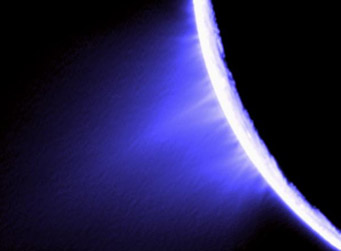
A false-color view of geysers jetting from near the south pole of Enceladus, as recorded by Cassini in 2005.
NASA / JPL / Space Science Inst.
What's gotten everyone buzzing is the realization that Enceladus is singlehandedly creating Saturn's broad E ring, thanks to the Cassini orbiter's discovery that eruptions near its south pole are spewing water-charged plumes hundreds of miles into space. Cassini observations show that the plumes are erupting from a quartet of 80-mile-long rifts (dubbed "tiger stripes") that are much warmer than their surroundings.
The heat to power all this activity — an astounding 15 gigawatts, based on the latest Cassini estimates — must be due to a tidal interaction with Saturn that's causing the icy crust to flex rhythmically during each orbit. This causes frictional heat to build up inside the icy moon. On paper, the heat must have created a subsurface global ocean at some depth, the "lubricant" that decouples the flexing crust from the moon's deeper interior.
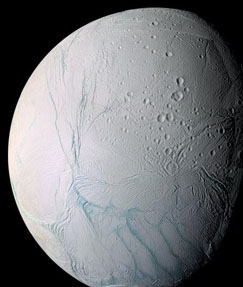
The tortured surface of Saturn's moon Enceladus exhibits five distinct terrain types, including four rifts near its south pole that are the source of its gas-and-particle plumes. Blue tints in this false-color view from Cassini indicate an icy surface covered with coarse grains and boulders. Click on the image for a larger view.
NASA / JPL / Space Science Inst.
In 2007 Jennifer Meyer and Jack Wisdom (MIT) discovered that Enceladus moves in and out of orbital resonances with the planet's other satellites. Right now, they say, a coupling with neighboring Dione has pumped up the orbital eccentricity of Enceladus. It's barely perceptible, just 0.005, yet that's enough to trigger the moon's tidal yin-yang with Saturn.
A few weeks ago, at a meeting of geophysicists in Toronto, a trio of dynamicists led by James Roberts (Applied Physics Laboratory) explained there almost has to be a layer of liquid water down there somewhere — it's the only physically plausible way to channel so much heat out of the interior. But they also emphasized that Enceladus can't possibly remain warm-hearted indefinitely — and consequently, given the current orbital arrangement, a subterranean water ocean is "likely to freeze on a geologically short timescale."
So if a hidden ocean exists, what's it like? Initially, the Cassini team envisioned a body of water so close to the icy surface that rivulets can escape upward along fractures and rush into space after explosively decompressing into vapor. Not everyone agrees with this "Cold Faithful" geyser model. Others have speculated that an ocean might not be needed at all. Instead, frozen water-based compounds called clathrates, which lock up volatile molecules like methane, carbon dioxide, or nitrogen, are decomposing into the jets of gas and ice.
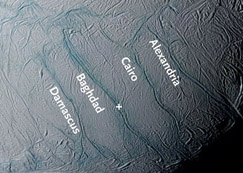
A closeup of the four 80-mile-long rifts near Enceladus's south pole (white cross). These "tiger stripes"are the source of its gas-and-particle plumes. Blue tints in this false-color view from Cassini indicate an icy surface covered with coarse grains and boulders.
NASA / JPL / Space Science Inst.
Fortunately, Cassini has been getting "up close and personal" with Enceladus of late. The craft brushed past the moon four times last year — including one daring dash directly through the towering plumes. Four more close flybys are planned within the next year, and another dozen could occur if NASA approves a proposed 7-year extension to the mission.
Two new results, published today in Nature, offer glimpses into the jets' true origin. In one, Frank Postberg (Max Planck Institute for Nuclear Physics) and others reveal that about 6% of the tiny particles in Saturn's E ring are quite salty, containing up to 1½% sodium chloride (NaCl). This makes sense if the ocean inside Enceladus has been in contact with deep-seated rocks for millions of years, long enough for sodium and other elements to leach into the water. Postberg's team concludes that the moon's ocean might be as salty as terrestrial seawater (6 to 20 grams of NaCl per kilogram).
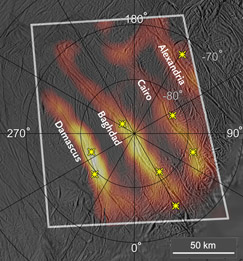
Thermal imaging from the Cassini spacecraft reveals heat escaping along the four sulci (dubbed "tiger stripes") near the south pole of Enceladus. The hottest location, at lower left along Damascus Sulcus, registers -135°F. Yellow stars mark the locations of the moon's dramatic jets. Click on the image for a larger view.
NASA / JPL / GSFC / SwRI / SSI
But an extensive effort to detect sodium in the plumes spectroscopically from Earth has come up empty. Even a trace should have been evident — atomic sodium has very strong emissions in yellow light. Nicholas Schneider (University of Colorado), who headed the observing team, concludes that the lack of sodium in the plume vapor rules out the near-surface geyser model, because in such an explosive getaway both the gas and particles should mimic each other's composition.
Instead, Schneider believes the saltless spectra imply that the gas is slowly evaporating in deep caverns below the surface — just like water escaping as vapor from the top of Earth's oceans. The gas collects in pressurized pockets until it can jet to space through fissures.
“This idea of slow evaporation from a deep cavernous ocean is not the dramatic idea that we imagined before," Schneider notes in a press release. He adds that other explanations are possible, including warm clathrate-rich ice decomposing and escaping to space — or liquid water created from the friction and heat when tidal flexure causes slabs of ice to rub against each other.
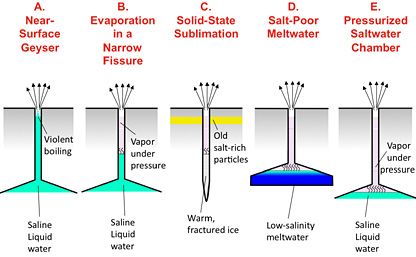
There's no shortage of ideas to explain the mechanism that fuels the powerful jets of gas and particles coming from Saturn's moon Enceladus.
NASA / JPL / SwRI / Univ. of Colorado
“These are all hypotheses, but we can’t verify any one with the results so far,” said Schneider. “We have to take them all with, well, a grain of salt.”
Cute turn of phrase, Nick.
But seriously, folks, Enceladus in exciting because its putative ocean is rapidly emerging as one of the places in the solar system most conducive to the development of life. As Cassini investigator John Spencer (Southwest Research Institute) notes in his accompanying Nature perspective, this little hotbed of activity appears to have all three of the basic ingredients: a source of heat, a suitable chemical mix, and liquid water.
 3
3
Comments
Rod
June 25, 2009 at 5:09 pm
When I read this report I note two items. 1. the surface of Enceladus looks young and 2. if an ocean exists beneath, that too would be young relative to the conventional age of the solar system, about 4.56 billion years. How data like this supports the evolution of life from non-living matter near the end of the report appears a challenging reach.
You must be logged in to post a comment.
Scott
June 26, 2009 at 5:45 pm
This is truly amazing on all levels. The first is how much that we really do not know, the second is that how these jets were spotted by the instrumentation, and thirdly just how much interrelation there is between the planetoids and planets.
You must be logged in to post a comment.
You must be logged in to post a comment.